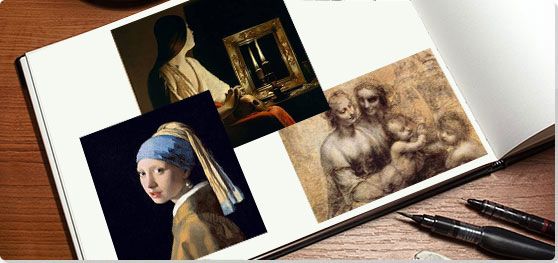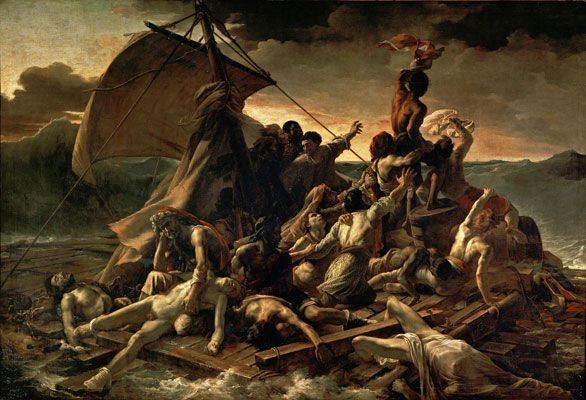Summary of Chiaroscuro, Tenebrism, and Sfumato
The grandeur of the Renaissance was mirrored by its equally lush style of artwork, out from which evolutions in drama and depth were innovatively conveyed. The era's artists accomplished this through new techniques centered upon the manipulation of light and dark, the father of which was chiaroscuro. Combining two Italian words - chiaro, "light" or "clear," and scuro, "dark" or "obscure," it became an artistic method using gradations of light and shadow to create convincing three-dimensional scenes where figures and objects appeared as solid forms. Leonardo da Vinci was a chiaroscuro master who subsequently pioneered sfumato. Meaning "to vanish like smoke," it was a method that involved applying layers of thin glazes to inform a foggy, almost ethereal effect. Caravaggio would play a leading role as well with his creation of tenebrism, another style that focused on the intense contrast between dark and light elements of a painting. It would become a defining stylistic feature of the Baroque period and, as a result, in contemporary usage often identifies the era. Many offshoots born of these techniques remain today for painters involved in that long lineage of artists interested in illuminating visual narratives out from the shadows.
Key Ideas & Accomplishments
- The Renaissance period brought a shift in modern thought toward Humanism, a movement that emphasized modern man as the center of the universe. A "rebirth" occurred in the arts and sciences and artists were elevated to genius status, subsequently becoming innovators of techniques such as linear and three-point perspective, sculpture in the round, and chiaroscuro. These techniques would inform the heart of some of the biggest artistic developments to occur over the previous 1,500 years.
- Chiaroscuro, tenebrism, and sfumato were used by artists for different purposes: to create an air of mystery, private intimacy, psychological complexity, to evoke nightmarish realities, to produce haunting dramatic encounters, or to suggest the metaphorical battle of light and darkness playing out in a variety of contexts.
- Many artists and iconic works were inspired by chiaroscuro, tenebrism, and sfumato including da Vinci's Mona Lisa (1503) and Venetian artist Tintoretto's Last Supper (1592-94). Some Mannerists, particularly the Spanish El Greco, adopted the style. Other Baroque artists who were also masters were Rembrandt, Peter Paul Rubens, Francisco de Zurbaran, and Diego Velázquez.
- In the 20th century, photography and filmmaking also strove for chiaroscuro effects as genres such as film noir naturally became new mediums upon which to explore the age-old concepts of light and dark.
Overview of Chiaroscuro, Tenebrism, and Sfumato
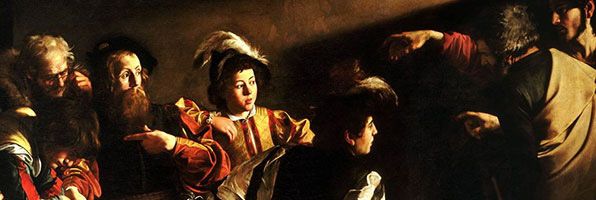
Caravaggio's handling of light made him legendary - a prime example for future generations of artists that empragnated their works with drama and meaning.
The Important Artists and Works of Chiaroscuro, Tenebrism, and Sfumato
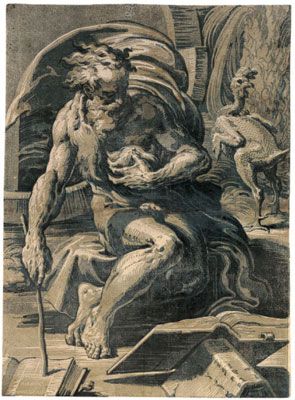
Diogenes
This woodcut shows the Greek philosopher Diogenes, a short stick in his right hand holding open the page of a book, as if marking a relevant text, with another open book in front of him. With his cloak swirling around him, conveying the sweeping energy of his thoughts, the figure is muscular and dynamic, torqued in contrapposto stance. On the right, a featherless rooster stands upon a ledge, its presence and extended legs evoking Plato's description of man as a featherless biped, which Diogenes replied to with, "Here is Plato's man" as he pointed to a plucked chicken.
A leading Cynic philosopher, Diogenes rejected all the pleasures and comforts of earthly life for a life of meditation. He was described as living in a wooden tub or barrel in a public square, reflected here in the setting, as the philosopher sits on a covered barrel and works with his "studio" around him.
Considered to be one of Ugo's masterworks, the print was made with a series of blocks in darker tones, in order to reproduce the rich tonality and three-dimensionality of Parmigianino's wash drawing. It's thought by some scholars that the two artists collaborated on this print. Ugo also collaborated with other leading artists, including Titian, and his prints were widely influential throughout Italy through the 17th century.
Chiaroscuro woodcut printed from four blocks in grey-green ink - The Metropolitan Museum of Art, New York
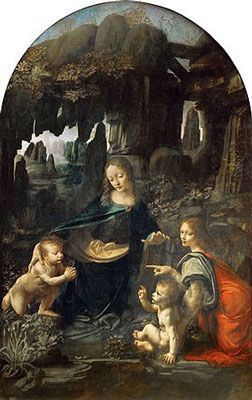
Virgin of the Rocks
This painting depicts the Virgin Mary with her right arm extended to embrace the child John the Baptist, while her left hand hovers in a gesture of blessing toward the Christ child, seated next to the archangel Gabriel. An effect of intimacy is conveyed, as the four seem to engage with the gestures and expressions of a lively sacra conversazione. The Madonna's mediating presence unifies the four, emphasized by the pyramidal but the subtle tonal transitions and blended outlines.
Here, da Vinci masterfully employs his signature style, combining chiaroscuro with sfumato to create three-dimensional space and naturalistic volumetric figures, animated with life. Chiaroscuro lends depth and mystery to the shadowy grotto in the background and the misty white landscape that extends in the distance, while at the same time the figures are illuminated as if from within, their faces and hands softly radiant. Dispensing with traditional halos, the artist conveys their holiness by means of light, and embodies the setting with precise observation, as seen in the specific species of plants growing at the edge of the water, and with anatomical accuracy, as seen in the dimples in the Christ child's arms.
This painting was immediately considered a masterwork and made da Vinci famous. It became a model for his contemporaries and subsequent artists and influenced the adoption of chiaroscuro throughout Europe.
Oil on wood transferred to canvas - Louvre Museum, Paris
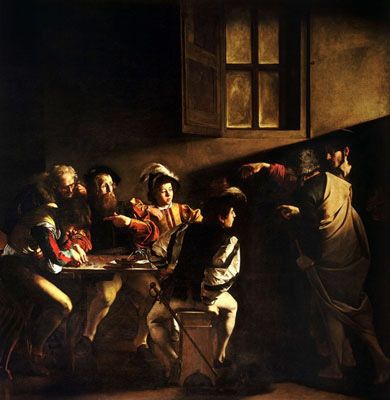
The Calling of Saint Matthew
This painting dramatically depicts the moment when Christ, standing on the right, calls Matthew, then a tax collector, to become one of his disciples. In a contemporary tavern, five tax collectors, foppishly dressed and seated at a table, react to the summons, embodied in a ray of light that seems to stream from Christ's beckoning hand and which illuminates their faces, emphasizing their expressions. The tavern's deep shadows, dark walls, and shrouded window suggest the mundane gloominess of the material world, as the man at the end of the table slumps over his arms, perhaps having drunk too much, or morosely staring at the few coins he has collected scattered on the table before him. The scene is almost theatrical due to the compositional effect of the intense contrast of dark and light.
Scholars debate whether Matthew is the figure at the end of the table or the bearded man, who points to himself with wonderment. Arguing for the latter explanation, Caravaggio depicted Matthew as similarly bearded in The Martyrdom of Saint Matthew (1600) and The Inspiration of Saint Matthew (1602), also painted for the Contarelli Chapel. His first important commission, these three works, employing tenebrism's intense contrast of dark and light to create a dramatic composition, made Caravaggio well-known and established him as the leading artist of the emerging Baroque period.
Oil on canvas - Contarelli Chapel, Church of San Luigi dei Francesi, Rome
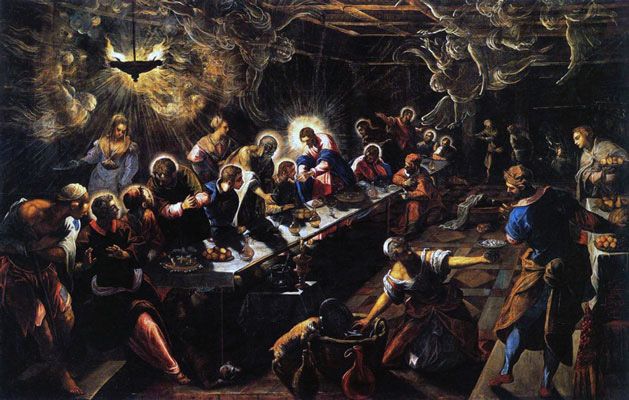
The Last Supper
This depiction of the Last Supper vigorously adopts chiaroscuro to create a surging scene where the walls become alive with swirling ghost-like apparitions, while illuminated angels surround a flaring lamp. Christ is the focus of the scene, intensely lit by a halo that surrounds his head and upper body as, standing, he offers bread to a disciple. Smaller halos identify the disciples seated at a long table, engaged in private conversations or sunk in solitary thought. Only a few are attentive to Christ, and the scene as if in a Venetian tavern resembles a kind of social gathering, chaotic and animated. The table's diagonal creates an asymmetrical composition, making the servants the central focus. Emphasized by the light above her, a woman, carrying a dish, draws the viewer's eye to the upper left hand of the canvas, while a kneeling woman, reaching into a barrel and holding out a plate to the man on her left, fills the foreground. The light, too, without a single source of origin is both chaotic and animated. With its asymmetrical composition, its rejection of a single light source and its swirling movement, the work reflects the Mannerist style, but at the same time signals the transition to the Baroque's emphasis on ordinary settings and dramatic scenes.
Oil on canvas - Church of San Giorgio Maggiore, Venice
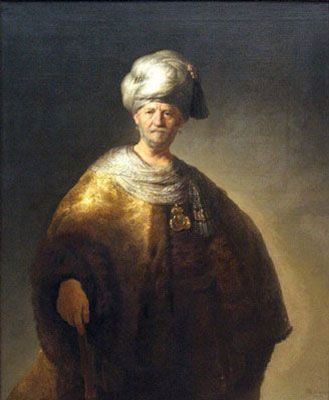
Man in Oriental Costume
This painting depicts a stately monumental figure dressed as an Eastern potentate (monarch or ruler) in a gold robe, silk turban, and scarf adorned with jewels. The painting conveys a sense of stately and imposing grandeur, as the man calmly but commandingly faces the viewer, the empty background behind him almost atmospheric as the darkness at the top of the frame takes on a subtle golden radiance around him.
Using a limited palette, Rembrandt developed his own signature style of chiaroscuro, which emphasized golden light radiating in profound darkness. A Baroque master, Rembrandt brought a sense of psychological complexity to his portraits, so that, while, often meditative, a sense of the subject's internal struggles and history was conveyed and captivated the viewer.
The work has also been known as The Noble Slav, and was painted by the artist after he moved to Amsterdam in order to attract knowledgeable collectors. At the time, paintings of "Oriental" figures were widely popular, reflecting the expansion of the Dutch trading companies into the Middle and Far East, and it was common to show models, as here, dressed in such clothing. In a sense what has been called Rembrandt's "golden light" was a kind of visual metaphor of the wealth of the era, known as the Dutch Golden Age.
Oil on canvas - The Metropolitan Museum of Art, New York
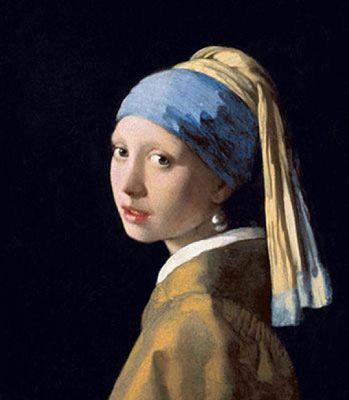
Girl with the Pearl Earring
This famous portrait depicts a young woman, standing before a dark background, as she gazes out at the viewer, her eyes luminous and her lips open as if she is just about to speak or has paused in mid-speech. Dressed in fine fabric, her dress soft with contrasting shadows and highlights of color, she wears an exotic blue turban while a large pearl, dangling from her ear, catches the light.
Viewed as iconic in the Dutch Golden Age, this work exemplified Vermeer's reputation as the "Master of Light," due to his mastery of chiaroscuro. The soft shadow that bathes the left side of her body and her turned face is subtle with variation, as, here, chiaroscuro is modulated by sfumato. Vermeer used very thin layers of sometimes almost translucent paint, applied with a brush of fine badger hair, to create the subtle transitions of skin tone, the pink and white highlights on her lips, and her bright gaze. The simplicity of the turban and dress focuses attention upon her face, modeled with great clarity, yet mysterious with feeling.
While the painting was a tronie, a genre that, popular at the time, showed a subject in foreign costume, it is also ambiguous, as her turban resembled no known Dutch or Oriental fashion of the time. The pearl, which is fabulously large, may also be made of tin. The luminous beauty and mystery of the painting has continued to fascinate both art historians and the general public into the 21st century.
Oil on canvas - The Mauritshuis, Amsterdam
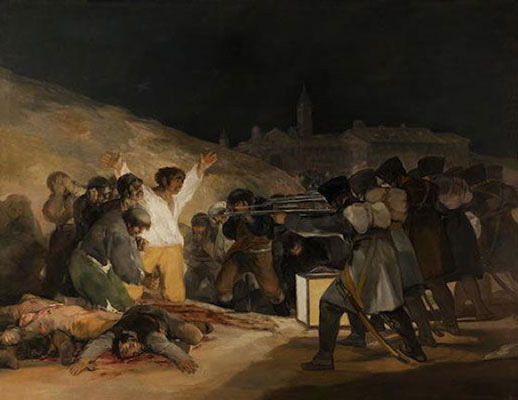
The Third of May 1808
This famous painting, considered to be among the first modern depictions of war, shows a number of unarmed Spaniards as they are about to be executed by a firing squad of Napoleon's troops. Illuminated by a light box placed on the makeshift execution square, a man, raising his arms as if in exhortation, confronts the dark menacing line of anonymous soldiers, as he stands between an anguished group about to be executed and the bodies of those already killed, sprawled on the ground. His white shirt and yellow pants, the only bright colors in a dark and gritty palette, not only draw the viewer's attention but add political and symbolic meaning, as the colors represent the Pope's personal guard that remained independent when Napoleon conquered the remaining Papal States in 1808. That same year, Napoleon's invasion of Spain launched the Peninsular War, a conflict so marked by brutality that the term guerilla warfare was used for the first time to describe the uprising of the ordinary Spanish people.
The central figure's resemblance to Christ crucified, including stigmata on his open palms, and the night lantern associated with the Roman soldiers who seized Christ, along with the use of tenebrism, placed the painting within the tradition of Spanish Baroque depictions of Christian martyrdom. However, Goya subverts that tradition, as the lantern becomes not a dramatic light source representative of divine illumination, but a grim tool for the firing squad to carry out its work. Similarly, the pleading man is not elevated as an individual martyr but only one anonymous victim among many, helpless before the ruthless mechanism of the state.
The work influenced many later artists, including Édouard Manet and Pablo Picasso, in part because of its raw depiction that, eschewing painterly technical skills and theatricality, unified method and subject in an indictment of political terror.
Oil on canvas - Museo Nacional del Prado, Madrid
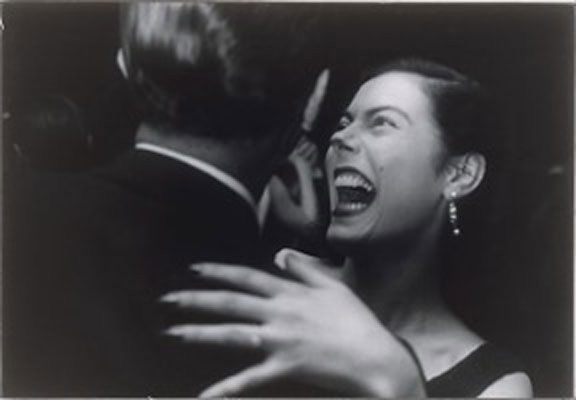
El Morocco, New York
This photograph, taken in Winogrand's pioneering snapshot style, shows a couple dancing at El Morocco, a hip 1950s New York nightclub. The image's confrontational style and close cropping emphasizes the woman's laugh, her teeth bared, her hand with sharp nails almost like claws along the man's shoulder. Here chiaroscuro, translated into the black and white photographic medium, heightens the effect, not only zeroing in on the intimate moment but blurring it so it becomes almost claustrophobic. The man, his back to the viewer, almost blends into the darkness, his reaction inscrutable, though the white line of his collar and the reflected light on the back of his head echo the skewed and off center composition.
The photograph captures the post-war era in the United States when a kind of relentless optimism, ignoring deeper social issues, was promoted in the media. Though working for mainstream magazines like Collier's, Harper's Bazaar, and Sports Illustrated, Winogrand had begun to question journalistic and artistic values. He sought to aggressively capture fleeting moments that registered a disturbing or dynamic impact while avoiding the ascription of meaning. His street photography and snapshot aesthetic were primary influences upon subsequent photographers.
Gelatin silver print - The Metropolitan Museum of Art, New York
Beginnings
Apollodoros and Skiagraphia
Trends leading to the development of chiaroscuro began in classical Greece where the artist Apollodoros was dubbed Apollodoros Skiagraphos, or "shadow painter." This was due to his invention of skiagraphia, or "shadow-painting," a technique that used cross hatching and gradations of tone. Unfortunately, as is the case with most classical Greek painting, his work has not survived, but the technique was widely adopted in Athens. Surviving in a more rudimentary form throughout the Byzantine era, skiagraphia was further developed by the use of incidendo and martizando, described by art historian Janis C. Bell as, "layerings of white, brown, or black in linear patterns over a uniform color," in the late Middle Ages in Europe. The technique was often employed in illuminated manuscripts.
The Renaissance
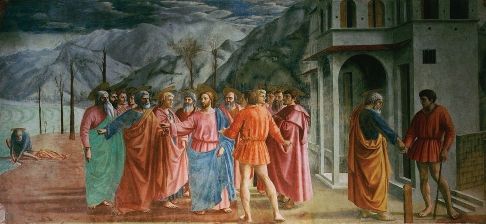
Emphasizing the revival of classic antiquity, Renaissance artists rediscovered and developed techniques that made it possible to create naturalistic but idealized figures inhabiting a convincing three-dimensional space. Masaccio's The Tribute Money (1420) was an early example of employing chiaroscuro to create volumetric figures, illuminated by a single light source outside the pictorial plane. However, it remained for Leonardo da Vinci to fully develop the technique, as seen in his Adoration of the Magi (1481) and The Virgin of the Rocks (1483-86). His figures and portraits, which seemed fluid and alive with light and shadow, influenced subsequent artists and also informed the subsequent development of the chiaroscuro woodcut. Artists in the Northern European Renaissance also adopted the technique, particularly for religious art, in part due to the influence of the 14th century Saint Bridget of Sweden. Her famous vision of the Nativity of Jesus described the Christ Child, resting on the ground, his body emitting light, while a blonde Virgin Mary, attended by Joseph, knelt to pray to Him. The vision became the model for the popular subject, also called the Adoration of the Child.
Baroque Art
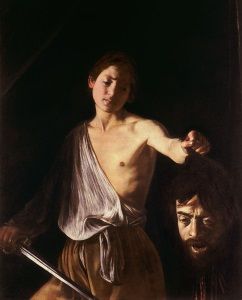
While Baroque art turned away from the asymmetrical compositions and extenuated, sometimes exaggerated, figuration of Mannerism to the classical principles of the Renaissance, emphasizing anatomically correct figuration and convincing three-dimensional space, it did so in order to emphasize dramatic scenes, almost theatrical settings, and intense individualistic expression. Rather than Leonardo's subtle transitions of color and light, Caravaggio took chiaroscuro further by developing tenebrism, using contrasts, as a gesture or a figure was intensely illuminated as if by a spotlight in a dark setting. In religious art, as seen in his ground-breaking triad of pictures, depicting the calling and martyrdom of Saint Matthew for the Contarelli Chapel in Rome, the technique made visually clear moments when ordinary reality was interrupted by the illumination of the divine. In secular art, as seen in his David with the Head of Goliath (1610), the technique could convey a profound and often tragic psychological complexity. Caravaggio was known as the "most famous artist in Rome,” and his use of chiaroscuro so influenced artists throughout Europe that, subsequently, the term has often been used synonymously with the era. However, many Baroque masters not only employed the technique but found it an essential element in creating a distinctive individual style, whether it was Rembrandt's golden light in Bathsheba at Her Bath (1654), Peter Paul Rubens's delight in color and sensuality in The Disembarkation of Marie de Medici at Marseilles (1621-1625), or Velázquez where shadows and light become the mystery of perception itself as in Las Meninas (1656).
Concepts and Trends
Chiaroscuro Drawing and Woodcuts
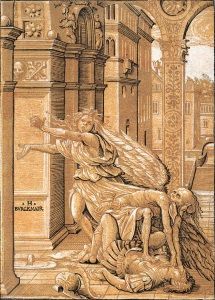
In the Renaissance, artists developed chiaroscuro drawing, as they added white for light effects and black for dark effects. Many of these works, along with Renaissance paintings and wash drawings, were in demand as reproductions, and, in 1508, the German artist Hans Burgkmair invented chiaroscuro woodcut prints. He first printed with a line block, inked in black, for contour lines and crosshatching, and then used additional blocks, inked in tonal variations, to create shading. By cutting away part of the block and leaving an area unprinted, artists created highlights in the monochromatic prints, which primarily used brown, black, gray, or green. Lucas Cranach the Elder, Niccolò Vicentino, Nicolò Boldrini, and Andrea Andreani were just some of the artists who adopted the technique, which also engaged Raphael, Parmigianino, and Titian. Innovations often followed. Ugo da Carpi became the first Italian artist to adopt the technique around 1516, and Italian artists usually printed with a series of tone blocks, emphasizing color transitions and leaving out the line block's black contours favored by Northern Europeans
Sfumato
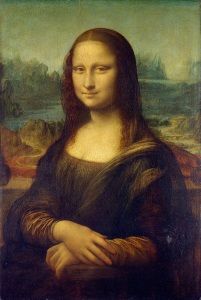
To show the effects of light upon curved surfaces and enhance the effects of chiaroscuro, Leonardo da Vinci perfected the technique of sfumato, which he described as "without lines or borders, in the manner of smoke or beyond the focus plane." Meaning, "to vanish like smoke," sfumato involved applying multiple thin layers of glaze to create soft tonal transitions and gradations between light and shadow and added subtle transitions to chiaroscuro. Later, Giorgio Vasari credited its invention to Jan van Eyck and Roger van der Weyden, two Early Renaissance Northern Europeans, but it was already identified with da Vinci, who mastered the technique in his Virgin of the Rocks (1483-1486) and The Mona Lisa (1503-1506). The technique required significant expertise, as modern scientists have discerned that the artist's glazes were sometimes only a micron in depth, and made of lead white to which one percent of vermillion had been added.
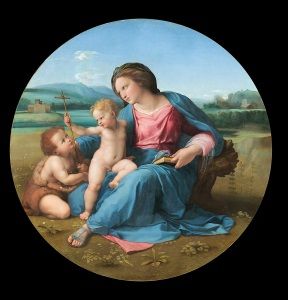
Other artists adopted the technique, including Raphael, Correggio, , and Giorgione, and it also influenced the "Leonardeschi", the name given to the large number of artists who associated with Leonardo or worked in his studio. Innovation followed, as Raphael developed what contemporary art historian Marcia B. Hall defined as unione. Seeking to combine sfumato's tonal qualities and soft shadows with his bright color palette, he used gradual color shifts to create blended edges, as seen in his Alba Madonna (c. 1510) celebrated for its vibrant color and flowing unity.
Tenebrism
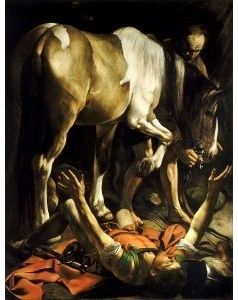
Tenebrism, derived from tenebroso, an Italian word meaning "dark, murky, gloomy," used dramatic contrasts between light and dark, as paintings with black areas and deep shadows would be intensely illuminated, often by a single light source. While tenebrism developed from chiaroscuro, unlike that technique, it did not strive for greater three-dimensionality, but was compositional, using deep darkness as a kind of negative space, while intense light in other areas created what has been called "dramatic illumination."
Though the Renaissance artist Albrecht Dürer and the Mannerists Tintoretto and El Greco used the technique earlier, tenebrism is usually identified with Caravaggio, who not only mastered the technique but made its "spotlight" effect a defining characteristic of his work. Due to works like The Martyrdom of St. Matthew (1600) he became widely influential, so much so that tenebristi, groups of artists employing the technique like the Utrecht School, were found throughout Northern Europe, Italy, and Spain. The term tenebrism was often applied to the works of Jusepe de Ribera, Francisco Ribalta, and other 17th century Spanish artists. At the same time, it was associated with the 17th century "candlelight tradition," a term describing night scenes illuminated by a single candle, as seen in some works by Gerrit van Honthorst, Rembrandt, and Georges de La Tour.
Later Developments
Following the Baroque period, chiaroscuro was an established technique, employed by various artists in the centuries that followed. The leading Rococo artists Fragonard, Watteau, and Joseph Wright of Derby, employed chiaroscuro in conveying moments of private intimacy and reverie. In the Romantic period, Géricault employed it to convey the tragedy of The Raft of the Medusa, while Henry Fusilli's painted the haunting Nightmare, and Francisco Goya's The Third of May depicted the darkness of political terror. The technique could be turned to different purposes that made it an important tool for creating an individual style into the modern era.
In the 20th century, photography and filmmaking also strove for chiaroscuro effects. Modernist photographers, including Ansel Adams, Edward Weston, and W. Eugene Smith, often used chiaroscuro, as the contrast of light and shadow emphasized the formal qualities of the image. Other photographers who have used the technique include Joseph Koudelka, Lothar Wolleh, Annie Leibovitz, Garry Winogrand, and Ralph Gibson. Studio photography often employs Rembrandt lighting, a technique that, using one light with a reflector or two light sources, is meant to create the chiaroscuro effects of the artist's portraits, translated into a modern medium.
In film the German Expressionists emphasized chiaroscuro, as seen in The Cabinet of Dr. Caligari (1920) and Nosferatu (1922), as well as Fritz Lang's Metropolis (1927).
In Hollywood, cinematographer Gregg Toland first used chiaroscuro in The Life and Death of 9413: a Hollywood Extra (1928) and his innovations in the 1930s informed the film noir genre and made him one of the most sought after cameramen. He worked with most of the leading directors, but is particularly known for his work on John Ford's The Long Voyage Home (1940) and Orson Welles' Citizen Kane. Creating deep focus compositions, Toland used shadow as a dramatic and pictorial device, defining the background from the foreground. He influenced many other cinematographers, including Vittorio Storaro, Vilmos Zsigmond, and László Kovács.
Other Hollywood filmmakers known for their use of chiaroscuro include William Dieterle, as seen in his The Hunchback of Notre Dame (1939) and The Devil and Daniel Webster (1941). The technique was equally prevalent in Europe. Sven Nykvist, who worked on many of Ingmar Bergman's films, used what has been called chiaroscuro realism, and the Russian filmmaker Andre Tarkovsky used chiaroscuro in the black and white scenes he included in Stalker (1979).
